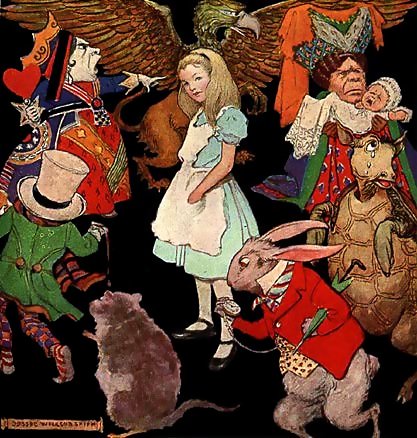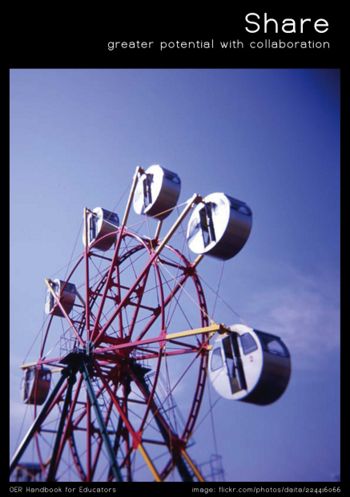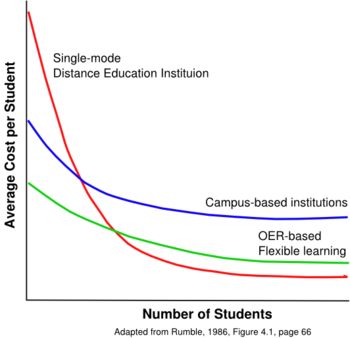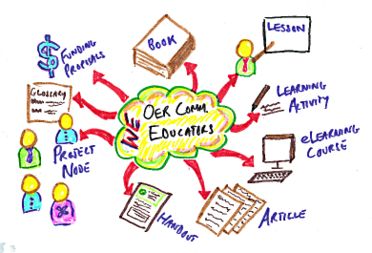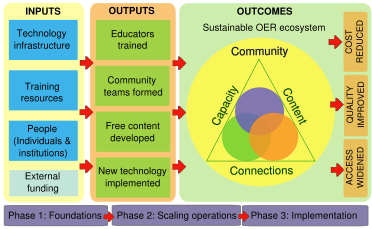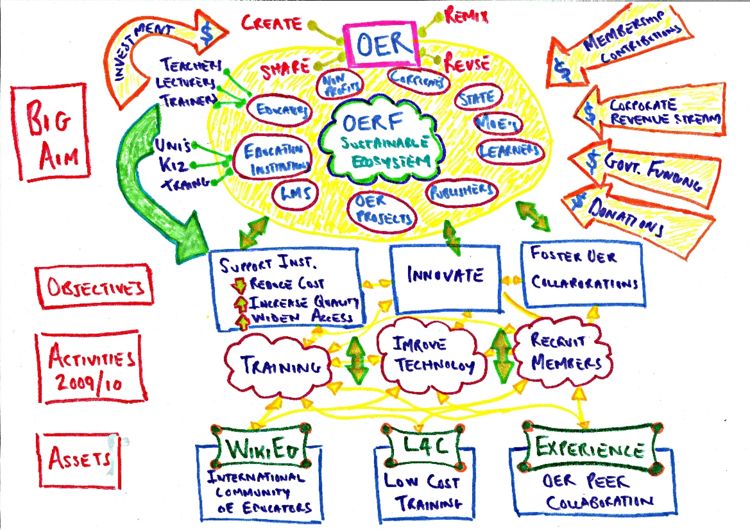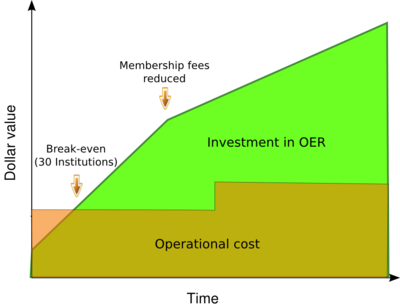Strategic plan
Contents
Executive summary
"We don't know where this experiment will lead, and that is exactly why we ought to try it." -- President Barack Obama, announcing open source courses for Community Colleges under the American Graduation Initiative[1]
Advances in digital technologies and the Internet, combined with innovative copyright licensing permissions, provide unique opportunities for individuals and organisations to collaborate on OER. An analysis of the strengths of the OER Foundation's major projects confirms a solid foundation on both the cost-leadership and product-differentiation dimensions of generic strategy development. The OER Foundation strategy aims to bridge two strategic gaps impeding OER adoption and implementation within the formal education sector. First, the evolution of economically sustainable OER ecosystems and second, the lack of collaboration, networking and content interoperability among mainstream OER initiatives.
The OER Foundation's extensive international community of educators, combined with a ground-breaking, low cost and scalable training model and extensive experience with open peer-collaboration approaches provides the platform for building a global leadership position in open education. Our strategic plan directs us to focus on three priorities:
- Assisting education institutions to achieve their aims by reducing cost, improving quality and widening the diversity of curriculum offerings through the use of open education resources.
- Fostering international networking and collaboration among mainstream open education projects.
- Relevant and appropriate technology innovation.
The OER Foundation provides institutions and educators with a model and global network to facilitate a return to the core values of education. That is, to share knowledge freely in a renewable and sustainable way.
Purpose of this document
The purpose of this document is to:
|
Introducing the OER Foundation
The Open Education Resource (OER) Foundation is an independent, not-for-profit organisation that provides leadership, networking and support for institutions and educators to achieve their objectives through open education. Registered in April 2009 under the New Zealand Companies Act of 1993, the activities of the company are restricted to charitable education purposes.
The OER Foundation will raise, administer and invest funds for the purpose of supporting the adoption and implementation of OER for the benefit of education institutions and the learner communities they serve. The OER Foundation leads a number of ground breaking open content projects. WikiEducator is a flagship initiative, and the OER Foundation's policy statement commits the organisation to support and maintain the technical and operational infrastructure of the WikiEducator community in accordance with the policies approved by the WikiEducator Community Council.
Vision, Mission, Strategy and Values
| Vision | To foster and support the development of sustainable ecosystems for OER.
By 2015, in collaboration with the free culture movement, we aim to have digital OER in support of national curricula covering all levels of the formal education system (including the school, post-secondary and tertiary sectors) [2]. |
| Mission | To support educators and institutions in achieving their strategic objectives through Open Education Networks and Resources |
| Strategy |
|
| Values | The activities of the OER Foundation and the WikiEducator community are rooted in a set of core values. WE believe:
|
Strategic Initiatives Summary
The primary goal of the OER Foundation is to build community and foster networks so that open education becomes a natural consequence of educational activity. We will increase the inventory of OER assets and the successful implementation thereof in different learning environments. The strategy requires the OER Foundation to focus on four key initiatives over the next three to five years:
- Capability development: Continue with training initiatives supporting educators in building capability for increasing the inventory of OER and reuse in learning environments (for example, the Learning4Content project).
- Technology innovation: Focus on projects which make the technology easier for educators to use and implement innovations which will increase the return on OER investment for individual institutions (for example, the Connexions-WikiEducator OER Remix project.)
- Promoting research on the use of OER and widening opportunities for collaborative research and publication under open content licenses (for example, the WikiResearcher project).
- Recruiting institutional members: Launch and support the recruitment of contributing members to achieve financial sustainability of the OER Foundation leveraging the advantages of a global mass-collaboration initiative which will ensure that the collective benefits for individual institutions exceed the cost of membership
- Organisational and business development: Focus on building partnerships and strategic relationships which will foster the development of a sustainable OER ecosystem for the benefit of contributing members.
Strategy
The rising costs of education and the chronic shortage of time felt by most teachers are beginning to open the door to a broader acceptance of open content - 2009 Horizon Report (Australia-New Zealand Edition)[4].
Situation Analysis
The 2010 Horizon Report identifies open content as a significant technology that will affect the practice of teaching, learning, and creative enquiry. OER is growing and maturing in the formal education sector, however there are strategic gaps with reference to:
- institutionalising and realising the tangible benefits of OER for education providers;
- attaining financial sustainability of the open education movement at a macro-systems and organisational level;
- collaboration and content interoperability among mainstream OER initiatives; and
- underutilisation of global mass-peer collaboration approaches in OER development and reuse in the formal education sector.
The OER Foundation has been established to address these challenges.
OER environmental scan
The Internet provides unique opportunities for educators to access, use, modify, and share educational materials. Open Educational Resources, as these free materials are called, can include "full courses, textbooks, streaming videos, exams, software, and any other materials or techniques supporting learning"[5]. This section provides a brief overview and context of OER in the formal education sector.The more open content that is available, the more opportunity that exists for growing the overall stock of OER assets, which provides the opportunity to develop new models and processes that take advantage of this very different approach to resource creation and distribution. With a growing group of educators creating and using OER, the community's understanding of the phenomenon is also maturing, resulting in a cycle of continuous improvement through discovery, learning, experimentation, and sharing of the factors that enable growth. This cycle is resulting in tangible impacts for education with the launching of new organizations based on non-traditional assumptions about abundance, scarcity, collaboration, and production of knowledge artifacts, learning, and practice. The OER landscape includes a wide variety of projects that are starting to address the needs of institutions, educators, and students[6]. Consider, for example:
- The pioneering work of the William and Flora Hewlett Foundation[7] in seeding and supporting the transformation in education for sustainable OER futures.
- Massachusetts Institute of Technology's listing of 1900 courses under the MITOpenCourseware initiative[8]
- The establishment of Creative Commons in 2001, a non-profit corporation dedicated to the development of licenses and other tools to enable legal sharing, remix and reuse of content including ccLearn, a division dedicated to supporting open education resources[9].
- The OpenCourseware Consortium comprising more than 200 universities publishing open courses[10].
- The Connexions[11] project hosted by Rice University which now has published more than 8,300 reusable modules using a distributed authorship model.
- The OpenLearn initiative of the British Open University, which has published over 300 learning units accounting for over 5,400 learning hours[12].
- Athabasca University Press[13], the first university press dedicated entirely to open access publishing.
- The mass-collaboration projects of the WikiMedia Foundation[14], most notably: Wikipedia (a top ten website of the world which has succeeded in developing the largest repository of free content through volunteer contributions); Wikibooks; and Wikiversity.
- The WikiEducator project established by the Commonwealth of Learning and now operating as an independent project of the OER Foundation, based at Otago Polytechnic in New Zealand.
- UNESCO's international work in advocating OER among member states and fostering the development of an international OER community.
- The Open High School of Utah which is basing its curriculum on OER[15].
- Tertiary education institutions implementing changes to institutional policy in support of OER, for instance the Free Content, Free/Open Courseware Policy[16] passed by the Senate of the University of the Western Cape[17], South Africa in 2006, and a new OER friendly intellectual property policy adopted by Otago Polytechnic, New Zealand, in 2008[18].
Relative strengths and opportunities
This section considers the foundations established and WikiEducator's unique position in the OER landscape. WikiEducator, a flagship initiative of the OER Foundation, is a community of educators comprising 11,700 registered users (November 2009) collaborating on the development of OER. Established in 2006 under the mentorship of the Commonwealth of Learning the project has become a significant global player in the OER landscape. Named the Best Educational wiki in 2007 by eLearning opinion leader, Stephen Downes[19], and inaugural recipient of the MERLOT Africa Network's award for exemplary OER practices in 2008[20], the WikiEducator community has gained valuable OER experience which provides a solid foundation to extend future success of open content in the formal education sector.
Michael Porter's[21] generic strategies for competitive advantage provide a useful framework for this situational analysis when considering the strengths and opportunities pertaining to the OER Foundation's strategy. Porter's two generic strategies provide insight into how the OER Foundation can establish advantage for education institutions engaging in open content projects, specifically:
- cost leadership relating to how the OER Foundation can assist education institutions to improve efficiencies by using open content, and
- product differentiation regarding how WikiEducator and the OER Foundation can consolidate it's unique position in the OER landscape for the advantage of its members within the ecosystem.
Within the business world, the primary factors of competitive advantage are innovation, reputation and relationships. Consequently, the OER Foundation strategy must consider how these strategic approaches and factors of competitive advantage can be reconfigured for the non-profit educational sector using OER.
Cost leadership
Cost advantage occurs when institutions can deliver the same services as its competitors but at a lower cost or higher quality for the same price. Publicly funded institutions in the education sector do not "compete" in the business sense of the word, but clearly reductions in the cost of course development and delivery combined with improvements in quality are important considerations for sustainable futures in the education sector. The concept of “co-opetition” is well understood in the business world where corporations collaborate in order to compete better. Co-opetition refers to the practice where companies work together for selected parts of their business where they do not believe they have competitive advantage, and consequently agree to collaborate in areas where they can share common costs. Consider for example, the collaboration between Toyota and Peugeot Citroen who share design, component parts and a jointly owned manufacturing plant to produce competing city cars[22]. Similarly, the competitive advantage among education institutions does not necessarily lie in the learning content they prescribe, but rather in the quality of teaching, unique interactions provided through its community of scholars, diversity of learning opportunities, and learner support services.
Sharing the cost of developing educational content, is colloquially speaking, a "no-brainer" for sustainable education futures. OER is the prime vehicle to achieve reduced cost and improved quality in education in a digital world. However, realising these benefits for the sector requires:
- focused leadership,
- coordination and networking capabilities which extend beyond the traditional operations of individual education institutions, and
- an international community of educators who donate time and effort in achieving these aims.
The OER Foundation brings these factors together in a unique way which is difficult to achieve from the platform of an individual education institution. The OER Foundation will focus on supporting institutions to improve their cost leadership in the following ways:
- Reduced cost and improved quality through shared content development. In the case of traditional campus-based institutions, the development of materials used for flexible or distance delivery represents a significant investment and cost-addition resulting from the academic time and professional support services required for the development of high quality asynchronous learning resources (over and above the costs associated with campus delivery). The OER Foundation will facilitate collaborative authoring and learning design services so that institutions can share cost. Moreover, as the OER Foundation subscribes to Creative Commons Licensing which permits sharing and derivative works, individual institutions will be free to adapt, re-contextualise and re-brand the materials for local needs freeing up time to concentrate on facilitating high quality learning experiences for their students.
- Expanding professional development opportunities. Working alone, it is not cost effective for individual institutions to provide regular access to just-in-time professional development opportunities for teaching staff to improve their skills in using collaborative authoring tools for the development of OER. The OER Foundation will provide monthly access to online professional development opportunities facilitated by experienced international OER developers.
- International and inter-sectoral collaboration. Traditionally cross sector collaboration, for example between tertiary and secondary or between polytechnics and universities, is difficult to achieve thus limiting opportunities to capitalise on the economies of scale of shared technology infrastructure. Technology does not discriminate between sectors, thus presenting a significant opportunity for reduced cost for hosting an international OER collaboration and sharing the benefits of technology innovations and refinements for the benefit of all sectors. The OER Foundation uses open source software infrastructure, which apart from containing cost, also means that all our software developments will be freely available for use by all education institutions.
Product differentiation
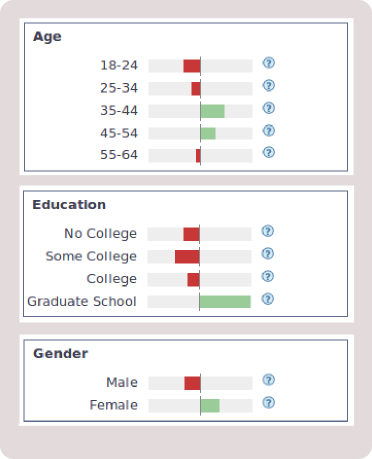
WikiEducator has established a distinctive niche in the global OER landscape with reference to mass-collaboration OER approaches, cross-institutional collaboration and organic growth in the formal education sector.
WikiEducator differentiates itself within the OER landscape in a number of ways:
- A focused education initiative: WikiEducator is a targeted education project focusing on the formal education sector, when compared, for instance, to general public projects like Wikipedia, Wikibooks or Wikiversity. This is evidenced by WikiEducator's traffic demographics relative to the general Internet population. With reference to Figure 4, WikiEducator attracts a higher proportion of the 35 - 54 age group when compared to the general Internet population, contrasted for example, with Wikiversity which shows a higher proportion of the 18 - 24 age group for the same indicator[25]. In addition, WikiEducator attracts a higher proportion of visitors with graduate qualifications and has succeeded in overcoming a male gender bias when contrasted, for example with Wikiversity which shows a male gender bias and lower proportion of visitors with graduate qualifications relative to the general Internet population. WikiEducator is uniquely positioned within the formal education sector when compared with the general Internet population.
- Self-organising OER community: WikiEducator has organised itself as a community of educators working on a range of different OER artifacts, for example: open textbooks, OER courses for online teaching, learning activities based on external resources, lessons, articles and research papers, handouts, glossary projects for use as reference resources, the establishment of project or community nodes, the development of funding proposals as free content etc. (See Figure 5.) Other projects within the OER landscape have organised themselves around the nature of the objects being produced, for instance: Encyclopaedia articles in the case of Wikipedia or books in the case of Wikibooks, school textbooks with reference to projects like the Free High School Science Texts. Using a community-based organising principle contributes to the flexibility and agility of the project because incorporating additional OER related projects are easily accommodated.
- Free cultural works approved content licensing: Since the inception of WikiEducator, the project has subscribed to Creative Commons licenses which meet the requirements of the free cultural works definition. Taking into account the recent decision by the Wikimedia Foundation to migrate from the GNU Free documentation license to the Creative Commons Attribution Sharealike license means that our content is now legally compatible with the largest database of OER in the world. This generates significant opportunities for content interoperability among Wikimedia Foundation projects, WikiEducator, Connexions and other OER initiatives which use compatible licenses. Sadly, many OER initiatives within the tertiary sector do not currently use free cultural works approved licenses and are excluded from remixing content from these sources. Moreover, our licensing choices permit us to collaborate with the corporate sector in generating a financially sustainable ecosystem without the risks of commercial exploitation.
- Refining technology and approaches for a mass peer-collaboration model: WikiEducator is based on the mass peer-collaboration model pioneered by Wikipedia. As a community of educators, WikiEducator has been able to prioritise and focus on developing the educational refinements which distinguish teaching materials from, for instance, encyclopaedia articles. Examples include: the use of pedagocial templates, experimentation with interactive templates[26], pioneering approaches associated with wiki-to-print[27] technologies (aimed at widening access to digital OER for learners who may not have access to the Internet), initiating work on the development of a quality assurance and review[28] framework suitable for the formal education sector, proof-of-concept[29] work for exporting WikiEducator collections as IMS content packages (which would enable seamless export of our content into institutionally hosted Learning Management Systems), and planning projects aimed at making the technology easier to use for the majority educators. This experience distinguishes the WikiEducator community from many of its OER counterparts in the formal sector.
- Differentiation through collaboration The prime purpose of the OER foundation is to foster the development of sustainable OER ecosystems through collaboration. The Foundation subscribes to the practice of of open philanthropy[30] which aims to effect social change through the principles of openness, transparency and networked collaboration. As such, all the OER Foundation's planning documents, projects and funding proposals are developed openly in WikiEducator. Through self organisation we are more agile and responsive than closed systems because our community network interacts dynamically with the system.
- Holistic strategy: WikiEducator has adopted a holistic strategy which incorporates capability development and strategic connections through relevant technology innovations in addition to OER content creation and reuse. (See Figure 6.) WikiEducator has implemented the Learning4Content training project, which is likely the world's largest attempt to develop wiki skills for education. This low cost model has demonstrated its ability to scale with more than 3,000 registered educators since January 2008 participating in over 80 workshops in 34 different countries. Our online Learning4Content workshops have drawn participants from 113 different countries and many Learning4Content graduates have become facilitators themselves. This holistic strategy development has contributed to accelerated growth curves when compared to those OER initiatives with a dominant content centric focus.
Strategic gaps
The OER foundation aims to bridge two significant barriers impeding OER adoption and implementation within the formal education sector:
- The absence of a global and sustainable OER ecosystem, and
- The lack of collaboration and content interoperability among mainstream OER initiatives.
Bridging these gaps requires a shift from individual organisational-based approaches to community networked approaches where OER development and reuse becomes a normal consequence of educational activities.
Challenges in achieving sustainability of OER in the formal education sector
A sustainable ecosystem requires that the elements of the system are continually engaged in a set of relationships with every other element constituting the environment in which they exist[31]. At the micro-level or nodal level of the OER ecosystem, there are early signs suggesting the potential sustainability of individual OER projects, for instance, Monterey Institute for Technology and Education[32], which is nearing the operational breakeven threshold. However, there is still much work needed in fostering the development of a sustainable OER ecosystem at the macro-level. There is a growing body of knowledge beginning to reflect on the sustainability question, for example Downes' (2006) work articulating different models for sustainable OER[33] and Dholakia, King, and Baraniuk's (2006) reflections on sustainability in the case of Connexions[34]. A number of important principles are emerging from these reflections:
- OER Learning infrastructure is fostered, not built: Self-sustaining OER systems will only be achieved when social, organizational, and cultural issues are resolved in tandem (Atkins, Brown and Hammond 2007:56)[35]. Self-organisation works best when the global pattern emerges from the collective interactions of the sub-elements where the rules of interaction are determined at the local level. Open wiki models exemplify these processes of self-organisation where local projects and initiatives can determine their rules of interaction and engagement, while simultaneously fueling the emergence of sustainable OER ecosystems at the macro-level. The wiki model enables incremental growth combined with flexible adaptation as knowledge and experience of the system grows.
- Sustainability is a value system, not merely an economic return for an OER product: An OER product, for instance a low-cost open textbook, is part of a larger system which should also include "volunteers and incentives, community and partnerships, co-production and sharing, distributed management and control" (Downes 2006)[33]. Consider for example, that school-level education in most countries are largely publicly-funded systems, consequently OER sustainability in this sector would benefit significantly by refinements in the national funding models as an incentive for the OER ecosystem, rather than reliance on a user-pay system where individual schools fund the development of OER products. By contrast, it is easier to achieve a membership-funding model through higher education consortia given higher levels of institutional autonomy.
- Support the development of a critical mass of active, engaged users that will scale: Digital OER content is scalable, however, in the absence of a critical mass of educators who create, remix and reuse OER the value chain for sustainability is broken. In order to scale participation and the rate of OER production and reuse by an order of magnitude, Atkins, Brown and Hammond (2007:24)[35] suggest focusing on approaches which enable "micro-contributions from many" [35]. This will enable the ecosystem to propagate the threshold number of "elements" required for sustainable self-organisation of a macro-level OER participatory learning infrastructure. A large number of participants provides the foundation for moving from pioneering individuals to institutional support for OER.
Collaboration, networking and content interoperability among mainstream OER initiatives
OER development approaches can be classified into two broad models:
- Producer-consumer models where an institution or consortium develops materials and releases courseware under an open license which can be reused by other providers, for example MIT's OpenCourseware[36] or the British Open University's Open Learn[37]. These approaches are derived from traditional academic publishing models utilising work flow methodologies and peer review processes.
- Commons-based peer-production models, a concept coined by Yochai Benkler[38], which encourage open and unrestricted participation by large numbers of educators utilising "powerful new models of production based on community, collaboration, and self-organization rather than on hierarchy and control" (Tapscott & Williams 2006)[39] for example WikiEducator, Wikipedia and GNU/Linux open source software operating system.
There are advantages and disadvantages to both approaches depending on the context and purpose of specific OER projects. Sadly, to date, there has not been much cross pollination between these approaches so as to capitalise on the "best of two worlds".
Currently, for instance, it is not possible for Connexions authors to open up their developments (or parts thereof) for open peer-collaboration, utilising the benefits of mass-collaboration approaches of the wiki model. Similarly, WikiEducator authors are not able to migrate collections of content into platforms which provide more traditional work flow features and administration of static instances of OER, utilising the Connexions "lens" feature for managing peer review within selected groups or consortia. This is a major restriction in that two leading OER projects which subscribe to approved licenses under the free cultural works definition are not able to easily exchange and remix content between the two platforms.
Moreover, these technical limitations exclude content remixing opportunities with the world's largest repository of free content, namely Wikipedia which is now possible as a result of the dual licensing decision[40] by the Wikimedia Foundation.
Clearly there is a need to provide seamless import/export functionality between the major OER projects in the formal education sector as a mechanism for scaling OER production and reuse. The OER Foundation strategy will address this gap to improve networking and interoperability among mainstream OER initiatives. In the future, educators around the world will be able to construct customised lessons and teaching materials based, for example on Wikipedia content. There are also significant technological opportunities for Connexions, WikiEducator and the Wikimedia Foundation to facilitate access and interoperability with the Wikimedia Commons -- a database of more than 4.2 million images and media files licensed under OER compatible licenses[41].
Theory of Change
The theory of change proposes the "ideal state" of a sustainable OER ecosystem which generates tangible benefits for individuals and institutions interacting within the system. Starting from the assets which we already have, the logic model identifies a path and supporting activities to achieve the objectives leading to the establishment of a sustainable OER ecosystem.
Aim (Big goal)
The aim of the OER Foundation is to foster the development of a sustainable OER ecosystem which increases the inventory of OER assets and wide scale reuse within our education systems. Consequently education institutions will need to realise tangible benefits (for instance reduced cost and improved quality) from participating in open content projects and facilitated engagement with an international open education community network. The major value proposition lies in opportunities for education institutions to improve efficiencies through OER resource creation, remix and distribution -- most notably reduction in cost and improvements in quality.
In the long term, working in collaboration with the free culture[42] movement, we aim to create and remix free digital content resources which will be available for sharing and reuse in support of all national curricula and sectors of the education system ranging from kindergarten through to all levels of the higher education system for use in formal, non-formal and informal educational settings.
A sustainable OER ecosystem will depend on individuals, governments, and institutions collaborating on selected OER projects. This ecosystem will include, for example:
- Education institutions, namely schools, institutes of technology and polytechnics, universities and training institutions who create and use OER within their delivery systems to reduce cost, improve quality and widen professional support networks.
- Learners who will benefit from:
- lower cost educational materials (including, open textbooks, online resources, multimedia etc.) thus widening access for all sectors and potentially reducing student debt in the tertiary sector,
- high quality learning experiences using OER, and
- active participation in the creation of the OER thus increasing the global inventory of open content.
- Ministries of Education who support OER initiatives to increase return on investment on government expenditure through:
- appropriate and supportive policy development for open content,
- earmarked funding for the creation of digital OER, national courses and open textbooks, and
- implementation of mechanisms to encourage and support capability development in relevant OER approaches technologies.
- State agencies like national libraries, curriculum and standards agencies, national information technology agencies, legislators, etc. who contribute to the development of a fertile and supportive policy environment for OER, by for instance, releasing publicly funded materials and outputs under open content licenses, collaborate with open content projects with reference to national qualification frameworks, facilitate storage, searching, and sharing of national resources under open access mechanisms.
- Learning management system (LMS) vendors and developers of the range of delivery technologies who ensure that their technical solutions interoperate well with OER to maximise portability, remixing and reuse.
- Mainstream OER projects and communities, including for example, the WikiMedia Foundation projects, WikiEducator, Connexions, OER Commons, the OpenCourseware Consortium, Open Learn, OER Africa and the UNESCO OER community who work towards breaking down project silos and foster improved collaboration and content interoperability so as to reduce unnecessary duplication of scarce OER resources.
- Educators committed to the core value of education namely to share knowledge freely. That is, teachers, lecturers, trainers, learning design professionals and educational technologists who donate time and provide professional services for creating, sharing and reusing OER for the benefit of the learners they serve.
- Non profit institutions dedicated to furthering the aims of the free culture movement, including for example Creative Commons[43], the Free Software Foundation[44], the Open Source Initiative[45], the Open Education Foundation and the Wikimedia Foundation.
- Publishers who have the foresight to extend and develop their business models to include publishing and distribution of open content using licenses which meet the requirements of the free cultural works definition[46].
- Other Corporates who will be able to extend or augment their business models through OER, for example, information technology companies who package services based on open content or related networks.
Revenue model of the OER Foundation
Open education represents a global revolution in teaching and learning where educators worldwide are developing a vast pool of educational resources on the Internet, open and free for all to use (Cape Town Open Education Declaration: 2008)[47]. However, the majority of OER projects within the formal education sector are reliant on donor funding for their operations, or unable to scale their activities beyond local-institutional investments. The OER Foundation has been established with the purpose of achieving financially sustainable and scalable models for OER for the benefit of its contributing members by harnessing the assets of planned inter-organisational networking and collaboration.
Wiki-based projects have the advantage of significantly lower breakeven thresholds (where revenue equals operational costs) due to significant cost efficiencies possible through mass-collaboration when compared to conventional closed approaches. As a non-profit entity registered for charitable educational purposes, the OER Foundation will reinvest surplus funds to support further development of open content (depicted by the green shaded area in the graphic) by remunerating authors and learning design professionals for the development of commissioned OER materials and open textbooks.
The business plan for the OER Foundation and WikiEducator is based on multiple and diverse revenue streams, including:
- Membership contributions from educational institutions (national and international) to contribute to the support of our technical infrastructure while benefiting from value-added services provided by the OER Foundation and profiled access to an international OER network of educators. Silver, Gold and Platinum members will have voting rights in determining priorities for commissioned OER content development projects funded through surplus revenue investments.
- Government funding in support of national education priorities using OER approaches to achieve sector-wide savings and improved return on investment. For example, selected open textbook projects, ear-marked funding for the collaborative development of OER content resources for eLearning, capability development of teaching staff or specified technology developments and tools refinement for identified educational requirements;
- Corporate revenue streams derived from partnerships and open commission agreements with independent business providers and consultants who generate value-added services around open content derived from the OER Foundation ecosystem. For example: learning design consultants who list their services on the OER Foundation network for prospective OER course developments, publishers who distribute and market OER textbooks sourced from WikiEducator, returning a nominal commission back to the community, or information technology companies that package hardware and services based on OER Foundation generated content. These arrangements provide a "win-win" solution for all stakeholders, for instance:
- Revenue generated through partnerships with the corporate sector are reinvested back into further OER content development for the benefit of the OER Foundation community;
- Publishers can reduce the risks and upfront development costs associated with educational texts utilising the benefits of print-on-demand publishing and opportunities for cost-effective distribution of highly customised texts. The OER movement benefits from marketing expertise and distribution channels of the publishing world thus widening access to OER with opportunities to promote local income generation in the developing world.
- Students benefit from lower cost textbooks. The market price will be regulated through the market and principles of self-organisation because there will always be a digital version of the content available for free download on WikiEducator thus avoiding the threat of monopolies thus promoting cost-efficient publishing. Implementing mass-customisation approaches and cost-efficiencies of industrial-scale printing technologies, publishers will be able to produce texts at market prices which are less than the comparable cost of an individual printing locally on a desktop printer while still maintaining a feasible profit margin for OER publishing in parallel with "closed-content" models.
- Donations and grants divided into the following categories:
- Grant funding from international donor agencies and foundations. This category of funding is reserved for strategic partnerships and strategic investments in building a participatory OER learning infrastructure so as to avoid dependencies on donor funding for operational expenditure.
- International aid in support of selected aid and development projects leveraging WikiEducator's extensive reach in the the developing world.
- Corporate philanthropy where corporate citizenship divisions sponsor key projects of WikiEducator and the OER Foundation. For instance, the OER Foundation plans to implement a FTE4WikiEducator project whereby institutions in the developing world, who may not be able to afford contributing membership status, may join the OER Foundation as a "contributing" member by allocating a predetermined staff-time allotment to work on OER for their institution. The OER Foundation will seek sponsorship for these FTE4WikiEducator members as a contribution to supporting the technology infrastructure of a large international OER collaboration and commissioned OER development projects.
- Public philanthropy through voluntary electronic contributions from the general public and institutions (for example, automated micro payment systems like PayPal for donations).
Strategic objectives
The key objectives for this phase of our strategy include:
- Supporting education institutions in implementing OER to:
- reduce cost associated with the creation and delivery of resources used in flexible and blended learning alternatives;
- improve quality of educational resources through collaboration and co-opetition approaches
- widen access to learning for potential students not currently served.
- Innovation, namely technological creativity successfully implemented in support of OER within the formal education sector. This will include, for example:
- usability refinements in the mass-collaboration, social networking tools customised for educational purposes, for instance implementing:
- a suitable rich text editing solution with pull down menu options for pedagogical templates
- peer review and work flow solutions designed specifically for the needs of education institutions
- templates and technologies to support learning design
- structures and solutions that make adapting content easier (e.g. transcluding selected subcomponents of content from different WikiEducator pages)
- enabling and promoting seamless interoperability among mainstream OER initiatives
- promoting portability of OER content for institutionally hosted delivery-technologies,
- extending the range of offline editing alternatives that can be used in conjunction with online OER content collaborations
- implementing technological solutions to support print-on-demand of OER resources for the publishing industry.
- usability refinements in the mass-collaboration, social networking tools customised for educational purposes, for instance implementing:
- Fostering OER collaborations, for example
- Working with Ministries of Education and other government agencies to implement national OER collaborations
- Establishing collaborations to support and encourage the mapping of OER content to national qualification frameworks and fostering the development of international qualification frameworks where appropriate
- Assisting education institutions to maximise their return on OER investment through best-practice derived from successful OER projects in WikiEducator and facilitating international connections through our global network
References and links
- ↑ http://www.whitehouse.gov/the_press_office/Remarks-by-the-President-on-the-American-Graduation-Initiative-in-Warren-MI/
- ↑ The OER Foundation and WikiEducator are working collaboratively with the free culture movement that promotes the freedom to distribute and modify creative works, using the Internet as well as other media in accordance with appropriately licensed content and respect for the rights of all copyright holders
- ↑ Free in this context refers to freedom of choice, not cost
- ↑ 2009 Horizon Report for Australia and New Zealand. Online: http://wp.nmc.org/horizon-anz-2009/section/two-to-three-years-open-content
- ↑ http://www.hewlett.org/oer
- ↑ Adapted from draft text by Ken Udas reflecting on the rationale of OER See:http://wikieducator.org/OER_Collaboration_in_African_Agricultural_Education/Rationale#Current_State_of_Open_Educational_Resources
- ↑ http://www.hewlett.org/oer
- ↑ http://ocw.mit.edu/OcwWeb/web/home/home/index.htm
- ↑ http://learn.creativecommons.org
- ↑ http://www.ocwconsortium.org/index.php
- ↑ http://www.cnx.org
- ↑ http://openlearn.open.ac.uk/
- ↑ http://www.aupress.ca/
- ↑ http://wikimediafoundation.org/wiki/Home
- ↑ http://openhighschool.org/
- ↑ http://ics.uwc.ac.za//usrfiles//users/8990060109/Strategies/freecourse-0.4.pdf
- ↑ http://freecourseware.uwc.ac.za/
- ↑ http://wikieducator.org/Otago_Polytechnic:_An_IP_policy_for_the_times
- ↑ http://halfanhour.blogspot.com/2007/12/not-edublog-award-winners.html
- ↑ http://wikieducator.org/images/2/20/MANeLA_Wikieducator_2008.pdf
- ↑ Porter, M.E. (1985) Competitive Advantage, Free Press, New York, 1985
- ↑ http://findarticles.com/p/articles/mi_kmafp/is_200503/ai_n13269158/?tag=content-inner;col1
- ↑ Rumble, Greville. 1986. The Planning and Management of Distance Education. London: Croom Helm
- ↑ Rumble, Greville. 1997. The Costs and Economics of Open and Distance Learning. London: Kogan Page in association with the Institute of Educational Technology, Open University.
- ↑ http://www.alexa.com/siteinfo/wikiversity.org
- ↑ http://www.wikieducator.org/User:Kruhly/MCQ
- ↑ http://wikimediafoundation.org/wiki/Press_releases/Wikis_Go_Printable
- ↑ http://www.wikieducator.org/WikiEducator:Quality_Assurance_and_Review
- ↑ http://www.wikieducator.org/WikiPublishing#How_It_Works
- ↑ http://commonspace.wordpress.com/2008/02/28/open-philanthropy-and-a-theory-of-change/ open philanthropy
- ↑ http://en.wikipedia.org/wiki/Human_ecosystem
- ↑ http://www.montereyinstitute.org/
- ↑ 33.0 33.1 S. Downes. 2006. Models for Sustainable Open Educational Resources, Online: http://www.downes.ca/cgi-bin/page.cgi?post=33401
- ↑ U. M. Dholakia, J. King, and R. G. Baraniuk. 2006. What Makes an Open Education Program Sustainable? The Case of Connexions. OECD Centre for Educational Research and Innovation (CERI) Closed Workshop Report. Online: http://www.oecd.org/dataoecd/3/6/36781781.pdf
- ↑ 35.0 35.1 35.2 35.3 D.E. Atkins, J.S. Brown & A.L. Hammond. 2007. A Review of the Open Educational Resources (OER) Movement: Achievements, Challenges, and New Opportunities. Report to The William and Flora Hewlett Foundation. Online: http://www.hewlett.org/download?guid=745fe08c-54de-102c-ae2b-0002b3e9a4de
- ↑ http://ocw.mit.edu/
- ↑ http://openlearn.open.ac.uk/
- ↑ http://en.wikipedia.org/wiki/Commons-based_peer_production
- ↑ D. Tapscott & A. D. Williams (2006). Wikinomics: How Mass Collaboration Changes Everything. Online: http://www.wikinomics.com/book/)
- ↑ http://blog.wikimedia.org/2009/05/21/wikimedia-community-approves-license-migration/
- ↑ http://commons.wikimedia.org/wiki/Main_Page
- ↑ http://www.free-culture.cc/
- ↑ http://www.creativecommons.org
- ↑ http://www.fsf.org/
- ↑ http://www.opensource.org/
- ↑ http://www.freedomdefined.org
- ↑ Cape Town Open Education Declaration. 2008. Available online: http://www.capetowndeclaration.org/press
